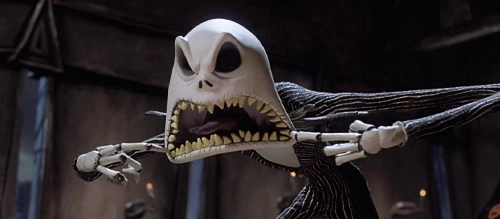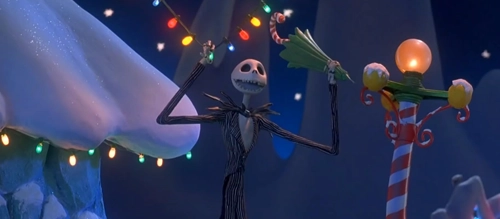‘The Nightmare Before Christmas’ at 30 – Review

The Nightmare Before Christmas (1993)
Director: Henry Selick
Screenwriter: Caroline Thompson
Starring: Danny Elfman, Chris Sarandon, Catherine O’Hara, William Hickey, Glenn Shadix, Paul Reubens, Ken Page, Edward Ivory
If a single word can be used to describe “Tim Burton’s” The Nightmare Before Christmas, it would be “alternative”. Released two years before Pixar’s Toy Story, it was Disney’s first feature-length animated film to not be produced in the traditional animation style, though Disney initially had the film released under their sister company Touchstone Pictures as they thought the film to be too frightening for young children. In the past three decades, The Nightmare Before Christmas has become the alternative watch at Christmas for those of a spookier disposition, whilst at Halloween it has been the perfect choice for those who can’t stomach hardcore horrors. Lead character Jack Skellington has become the unofficial mascot of alternative goth/emo kids, with Jack’s spooky face peering out of all manner of black clothes, rucksacks, mugs, etc. – how convenient of Disney to end Nightmare‘s banishment once they realised how much money they could make from it through merchandise.
The Nightmare Before Christmas started as a poem by Tim Burton (inspired by a department store’s hasty changing of the Halloween decorations to Christmas ones), which he pitched to Disney whilst he was working for them as an animator in the 1980s. It was quickly rejected by them, though they soon changed their tune after he left and directed the successful blockbuster Batman (1989). After the adaptation of the original poem by Michael McDowell, Caroline Thompson fleshed out the bare bones story into something of an almost mythological quality.
The brief prologue informs us that we are going to learn where holidays come from, before we are taken through a door with a pumpkin on it. Jack Skellington is the king of the pumpkin patch and is the figurehead of Halloweentown, the place responsible for carrying out Halloween celebrations in the human world. After another massively successful Halloween, Jack is showered with praise but he is left feeling empty. Achieving everything he can through his frightening prowess, he is left wishing to do more as he takes a solemn walk through the woods. After wandering all night, he comes across the other holiday doors, and after one catches his eye he tumbles headfirst into the bright and snowy world of Christmastown.
Completely enamoured with all of the sights and sounds of Christmas, he can’t help but to desperately try and understand more about the Christmas Holiday. However, Jack’s natural spookiness means he struggles to grasp the true nature of Christmas; in this quest to understand this new fantasy, Jack decides that Halloweentown should take over the Christmas celebrations this year, turning the season into a wholly horrifying and macabre affair.
It is still greatly debated whether The Nightmare Before Christmas is truly Tim Burton’s. He is credited as producer and the author of the original idea, but it was very much Henry Selick in the director’s chair and Caroline Thompson behind the typewriter. He was not a constant presence in the animation house, only popping into the San Francisco studios a few times a year. His original poem only outlined three characters in the film (Jack, Zero and Santa Claus), whilst it was McDowell’s and Thompson’s writing, alongside the creativity of the animators, that produced the bulk of the monsters and ghouls that inhabit Halloweentown. Burton’s influence and supervision is, however, evident within the gothic artistic style directly inspired by his original sketches, which is comparable to his other animated works such as Corpse Bride and Frankenweenie. He also very much had the final word when it came to the script – after he was told the original intended ending, he hated it so much he had to leave the room to kick a hole in the wall.

The most important influence Tim Burton had on The Nightmare Before Christmas was leaving Danny Elfman in charge of its music. Writing most of the principle songs before the script was finalised using the brief story points of Burton’s poem, Elfman stacked 10 distinct songs into the 76-minute runtime, transforming the movie into a veritable opera. Through Elfman’s musical prowess and emotional intelligence, a great deal of heart was put into the songwriting process, with Elfman confessing that he strongly empathised with Jack’s character. Being a member of the band Oingo Boingo, Elfman achieved massive success but was beginning to feel fatigued and was feeling the temptation of a change in work. Using this self-reflection and his own vocal talent (after asking Burton for Jack’s role), Elfman’s musical direction transformed The Nightmare Before Christmas from something akin to a Halloween TV Special into high art.
The exquisite quality of the music accentuates the other highlights of the production, and as the film behaves like an opera, most of the crucial plot points and characterisation are contained within it. Fan favourites “This is Halloween” and “What’s This” draw attention to the creativity of the art design of the different holiday locations: Christmastown is straight out of Dr Seuss whilst Halloweentown is an homage to the greats of German Expressionism, filled with the most delightfully gruesome inhabitants.
The operatic style of the storytelling is what makes Nightmare a modern fairy tale. The story is extremely economical with initially little motivation given for the characters’ moods and actions: Jack wants more than just frightening people because he says so in “Jack’s Lament”; Sally loves Jack because she sings that she does so in “Sally’s Song”. In this simplicity, they become the mythical creatures straight out of ‘tales as old as time’. Given the charm instilled by the vocalisation achieved by the cast, particularly by Catherine O’Hara as Shock and Sally, it is no wonder that after 30 years these characters are still adored. A great demonstration of the masterful orchestration of the talents of voice and animation is “Oogie Boogie’s Song”, in which Ken Page has the time of his life bringing to life one of Disney’s coolest villains with his casino-style lair being one of the most memorable in the history of stop motion animation.
In the 30 years since its release, stop motion animation has come along in leaps and bounds. It may lack the smoothness of more recent Laika releases, but such imperfections only add to a film with bags of charm. With this passage of time, it becomes more clearly evident that The Nightmare Before Christmas was a flash of lightning captured in a bottle. With the support of Tim Burton, Selick’s burgeoning aspirations, Elfman’s earnestness, and a cast of Burton favourites, The Nightmare Before Christmas remains the most perfect little Halloween treat for all to see. Jack Skellington is not just the King of the Pumpkin Patch, after 30 years he is the King of the Goths.
Score: 23/24

